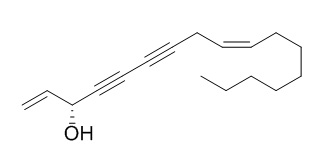Falcarinol
Falcarinol has effects on CaCo-2 cells appear to be biphasic, inducing pro-proliferative and apoptotic characteristics at low and high concentrations of Falcarinol, respectively. Falcarinol-associated dermatitis is due to antagonism of the CB(1) receptor in keratinocytes, leading to increased chemokine expression and aggravation of histamine action.
Inquire / Order:
manager@chemfaces.com
Technical Inquiries:
service@chemfaces.com
Tel:
+86-27-84237783
Fax:
+86-27-84254680
Address:
1 Building, No. 83, CheCheng Rd., Wuhan Economic and Technological Development Zone, Wuhan, Hubei 430056, PRC
Providing storage is as stated on the product vial and the vial is kept tightly sealed, the product can be stored for up to
24 months(2-8C).
Wherever possible, you should prepare and use solutions on the same day. However, if you need to make up stock solutions in advance, we recommend that you store the solution as aliquots in tightly sealed vials at -20C. Generally, these will be useable for up to two weeks. Before use, and prior to opening the vial we recommend that you allow your product to equilibrate to room temperature for at least 1 hour.
Need more advice on solubility, usage and handling? Please email to: service@chemfaces.com
The packaging of the product may have turned upside down during transportation, resulting in the natural compounds adhering to the neck or cap of the vial. take the vial out of its packaging and gently shake to let the compounds fall to the bottom of the vial. for liquid products, centrifuge at 200-500 RPM to gather the liquid at the bottom of the vial. try to avoid loss or contamination during handling.
Sci Rep.2017, 7(1):3249
Plos One.2020, 10.1371
Metabolites. 2023, 13(11):1122.
Food Res Int.2017, 96:40-45
Phytomedicine.2021, 83:153483.
Mol Med Rep.2015, 12(5):7789-95
Microchemical Journal2023. 191:108938
Research Square2021, 10.21203.
Korean J. Food Preserv.2023, 30(4):663-668.
J Mol Recognit.2020, 33(2):e2819
Related and Featured Products
Biochem Pharmacol. 2010 Jun 15;79(12):1815-26.
Falcarinol is a covalent cannabinoid CB1 receptor antagonist and induces pro-allergic effects in skin.[Pubmed:
20206138]
The skin irritant polyyne Falcarinol (panaxynol, carotatoxin) is found in carrots, parsley, celery, and in the medicinal plant Panax ginseng.
METHODS AND RESULTS:
In our ongoing search for new cannabinoid (CB) receptor ligands we have isolated Falcarinol from the endemic Sardinian plant Seseli praecox. We show that Falcarinol exhibits binding affinity to both human CB receptors but selectively alkylates the anandamide binding site in the CB(1) receptor (K(i)=594nM), acting as covalent inverse agonist in CB(1) receptor-transfected CHO cells. Given the inherent instability of purified Falcarinol we repeatedly isolated this compound for biological characterization and one new polyyne was characterized. In human HaCaT keratinocytes Falcarinol increased the expression of the pro-allergic chemokines IL-8 and CCL2/MCP-1 in a CB(1) receptor-dependent manner. Moreover, Falcarinol inhibited the effects of anandamide on TNF-alpha stimulated keratinocytes. In vivo, Falcarinol strongly aggravated histamine-induced oedema reactions in skin prick tests. Both effects were also obtained with the CB(1) receptor inverse agonist rimonabant, thus indicating the potential role of the CB(1) receptor in skin immunopharmacology.
CONCLUSIONS:
Our data suggest anti-allergic effects of anandamide and that Falcarinol-associated dermatitis is due to antagonism of the CB(1) receptor in keratinocytes, leading to increased chemokine expression and aggravation of histamine action.
Cancer Lett . 2018 Jan 1;412:297-307.
Panaxynol, a natural Hsp90 inhibitor, effectively targets both lung cancer stem and non-stem cells[Pubmed:
29061506]
Abstract
Cancer stem-like cells (CSCs) contribute to tumor recurrence and chemoresistance. Hence, strategies targeting CSCs are crucial for effective anticancer therapies. Here, we demonstrate the capacities of the non-saponin fraction of Panax ginseng and its active principle panaxynol to inhibit Hsp90 function and viability of both non-CSC and CSC populations of NSCLC in vitro and in vivo. Panaxynol inhibited the sphere forming ability of NSCLC CSCs at nanomolar concentrations, and micromolar concentrations of panaxynol suppressed the viability of NSCLC cells (non-CSCs) and their sublines carrying acquired chemoresistance with minimal effect on normal cells derived from various organs. Orally administered panaxynol significantly reduced lung tumorigenesis in KrasG12D/+ transgenic mice and mice carrying NSCLC xenografts without detectable toxicity. Mechanistically, panaxynol disrupted Hsp90 function by binding to the N-terminal and C-terminal ATP-binding pockets of Hsp90 without increasing Hsp70 expression. These data suggest the potential of panaxynol as a natural Hsp90 inhibitor targeting both the N-terminal and C-terminal of Hsp90 with limited toxicities.
Keywords: Cancer stem cells; Heat shock protein; Lung cancer; Panaxynol.
J Agric Food Chem. 2007 Feb 7;55(3):618-23.
Biphasic effect of falcarinol on caco-2 cell proliferation, DNA damage, and apoptosis.[Pubmed:
17263451]
The polyacetylene Falcarinol, isolated from carrots, has been shown to be protective against chemically induced colon cancer development in rats, but the mechanisms are not fully understood.
METHODS AND RESULTS:
In this study CaCo-2 cells were exposed to Falcarinol (0.5-100 microM) and the effects on proliferation, DNA damage, and apoptosis investigated. Low-dose Falcarinol exposure (0.5-10 microM) decreased expression of the apoptosis indicator caspase-3 concomitantly with decreased basal DNA strand breakage. Cell proliferation was increased (1-10 microM), whereas cellular attachment was unaffected by <10 microM Falcarinol. At concentrations above 20 microM Falcarinol, proliferation of CaCo-2 cells decreased and the number of cells expressing active caspase-3 increased simultaneously with increased cell detachment. Furthermore, DNA single-strand breakage was significantly increased at concentrations above 10 microM Falcarinol.
CONCLUSIONS:
Thus, the effects of Falcarinol on CaCo-2 cells appear to be biphasic, inducing pro-proliferative and apoptotic characteristics at low and high concentrations of Falcarinol, respectively.
Verbasoside
Catalog No: CFN95015
CAS No: 61548-34-3
Price: $318/5mg
Licoricesaponin H2
Catalog No: CFN95173
CAS No: 118441-85-3
Price: $368/20mg
[(1(10)E,2R,4R)]-2-Methoxy-8,12-epoxygemacra-1(10),7,11-trien-6-one
Catalog No: CFN95198
CAS No: 75412-95-2
Price: $318/10mg
N-Methylcorydalmine
Catalog No: CFN95204
CAS No: 81010-29-9
Price: $398/5mg
Cannabisin B
Catalog No: CFN95268
CAS No: 144506-17-2
Price: $413/5mg
3',4',5',5,7-Pentamethoxyflavanone
Catalog No: CFN95414
CAS No: 479672-30-5
Price: $218/20mg
Citrusin C
Catalog No: CFN95420
CAS No: 18604-50-7
Price: $318/10mg
Pinocembrin 7-O-(4'',6''-hexahydroxydiphenoyl)-beta-D-glucose
Catalog No: CFN95462
CAS No: 1825287-22-6
Price: $318/10mg
Oxytroflavoside F
Catalog No: CFN95489
CAS No: 1391144-85-6
Price: $318/5mg
Gossypetin 3-sophoroside-8-glucoside
Catalog No: CFN95528
CAS No: 77306-93-5
Price: $318/5mg



